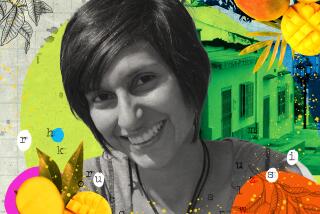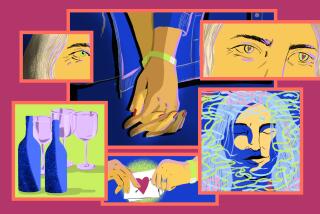Susan Spano talks about great trips, wild dogs and her new book
Susan Spano’s name might ring a bell. It appeared in the pages of the Los Angeles Times 941 times from 1998 through 2009, when Spano served as a staff travel writer and columnist. Before that, she wrote the Frugal Traveler column for the New York Times.
Now Spano has published “French Ghosts, Russian Nights & American Outlaws: Souvenirs of a Professional Vagabond” (Roaring Forties Press, 190 pages, $15.95), a collection that circles the world, delivering perspective from her years as a traveler and an expat in Paris, Beijing and Rome.
A few months short of her 60th birthday, she’s also on the brink of another departure, one that’s likely to take her abroad for a couple of years. But when we launched into this Q&A, we started with her beginnings as a travel writer.
Q: In the book, you note that your mother taught geography and say that travel was probably hard-wired into your personality. But before you started writing about travel, you spent much of your 20s living in New York, serving as writer and editor on magazine and book projects from Nancy Drew to divorce. Was there a single trip that launched you as a travel writer?
A: “Yes. I was in my early 30s and I went to France and italy.…I took a train from Pau, in the Pyrenees, all the way around the Mediterranean to Rome. And I was just very green at the time. I had already written one thing for the New York Times, which I believed was a kind of fluke. But in the course of that trip, I sort of got an education in solo travel, especially for a woman, and especially the soulfullness of it.”
Even though no specific article came out of that trip, Spano says, it reshaped her as a writer and showed her how fulfilling solo travel could be. On an organized tour, Spano said, you too often get “herded around.” In a group, “you have to negotiate.” But “if you’re traveling by yourself, it’s an opportunity to really do what you want, and really be able to hear yourself think. All the things you think during the course of a day at home just come and go. But when you think of them on the road, they stand out. And you have a chance to deepen them, to think your deepest thoughts, even if you thought you didn’t have any.”
Moreover, Spano writes in the book, “When I travel with a companion I’m not as capable as I am when I’m by myself, just because I don’t have to be.”
Q: You’ve spent most of the last 15 years living abroad , including Beijing and Rome. But your first overseas stint was Paris. How did that happen?
A: “I had a very understanding editor and I was able to make the case that I would know much more about what was happening on the travel front if I was closer to what was happening [in Europe]. And that turned out to be true.” Also, “As dear to me as my native country is, I like being someplace else.”
However, “while I was going through it, I managed to find things to complain about. Even in the 7th arrondissement on Rue de Beaune [in Paris], I found things to complain about. Frequently bad food. Snotty merchants. Failure of the French to clean up after their dogs.” But “I lived a block off the Seine. So I looked up and I could see the Eiffel tower and I could look down and see Ile de la Cite. It is a breathtaking city, and I did come to love the persnickety French.”
Q: Favorite foreign posting?
A: “Rome. Food. Life. Pace. Rome was the best.”
Q: Favorite hotel?
A: “I used to love this place in Oaxaca called the Hotel Las Golondrinas. It’s a budget place in the town. Frequented by academics and study-abroad people. Pretty garden. Pottery. Off the square. Great breakfast. I think it was $18.” [Doubles are now priced about $65 per night.]
Q: In this book, you mention several scary moments. The one that spooked me most was about 20 years ago, on the Polynesian Island of Huahine, when you went looking for a stone shrine. And then…
A: “There was a little park and I was all by myself walking through the jungle. And then a dog came and started snapping at me. And then another dog. And then another. And then I picked up a stick and started swiping at them. And then more came. And more and more. Until I bet there were 80 dogs around me. It was really scary. And then somebody whistled from afar. I think it was some man working in a field somewhere. And the dogs dispersed. I don’t know how or why, but they did.... So I went and saw the shrine. It was not worth any of it.”
Q: People often expect travel stories to be all sweetness and light, but yours aren’t. Explain.
“I do have a tendency to want to write about difficult things. I like to tell stories about the Khmer Rouge and about sites related to Mao in China, and I like to tell stories about the Belgian museum full of things that the Belgians looted from the Congo. Those would seem to be hard stories, but they’re what I like to tell.… If you travel, you find out that what you thought was true is not necessarily true…. The stories they tell in America are not the same as the stories they tell in France or Cambodia or Mexico even.
“It’s not about sweet and sour. It’s about getting another perspective from the one you grew up with. It’s really about intercultural understanding.”
Q: So now, after all these years of carefully choosing destinations, you’ve signed onto the Peace Corps. This means you’ve basically rolled the dice on your whereabouts for the next two years, beginning in August. Why? And where are you going?
A: “It was a very sensible coda for my travels. I’m single and have the ability to do it, and of course the Peace Corps is an organization that I’ve really admired.” Also, “I wanted to bring to it some kind of skill. So I’ve been learning how to teach English as a second language” at the Monterey Institute of International Studies.
In part because of the time she’d spent speaking French, Spano was “fairly sure” that she’d be assigned somewhere in West Africa. “I also thought Southeast Asia would be possible, which I would have loved…. I was really surprised when I got Armenia.”
Q: And your mental image of Armenia is…
A: “I don’t have ideas about Armenia. Nothing. I know about the genocide” committed by Turks against Armenians during and after World War I. “And that it was the first Christian nation in the world…I know about Armenian flatbread. I know that there are lots of Armenians in L.A. And now I know that the Armenian language is one of the hardest in the world to learn.”
While learning about all things Armenian, “I’m going to be teaching English to teachers and to secondary school students.” Instead of Yerevan, the capital, “I rather hope I’ll be in some out of-the-way place. With hot water.”
Between duties, “I plan to travel on the silk road. To see Baku [in nearby Azerbaijan]. To do a lot of Turkey.
“I’ve been really lucky, to make my vocation travel. There are so many people who would like to do that, and I was just in the right place at the right time. On several occasions. And I did try to make the absolute most I could out of it.”
More to Read
Sign up for The Wild
We’ll help you find the best places to hike, bike and run, as well as the perfect silent spots for meditation and yoga.
You may occasionally receive promotional content from the Los Angeles Times.







